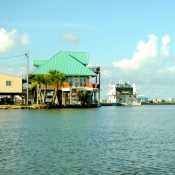The Infrastructure Opportunity Nobody Is Talking About – Yet
While there isn’t much disagreement that America’s infrastructure needs fixing, determining which areas to prioritize remains a challenge. Which investments will deliver the most bang for our buck? Steve Cochran of the Environmental Defense Fund says investing in coastal restoration presents huge cost-effective opportunities to create new jobs and safeguard national security.

Originally posted on the EDF blog.
7 March 2017 | In the divisive political atmosphere of 2017, there is one issue that leaders across the spectrum agree on: The immediate and compelling need to rebuild America’s worn and damaged infrastructure.
Governors from 49 states have already sent a list of more than 400 projects they want President Trump to target with his promised $1 trillion infrastructure plan, which the president is expected to address in a speech tonight. With so much urgent work to choose from, how do we know which investments give us most bang for the buck?
The answer may surprise you: Coastal protection and restoration. It’s easy to see why.
Big coastal cities face big losses
Coastal counties make up only 10 percent of our nation’s landmass but account for 42 percent of the nation’s Gross Domestic Product. Nearly 160 million people live in our nation’s densely packed coastal communities.
And yet, our coasts have largely been stripped of their natural protections under the pressures of erosion, development, straightjacketed rivers – and now, rising seas.
This has left major cities such as New York and New Orleans swamped by storm surge, caused billions of dollars in damage to economically significant ports, highways and other infrastructure, and racked up tens of billions of dollars in economic losses.
It’s also why coastal restoration projects, when done well, can do more than any other to grow the nation’s economy, safeguard national security, save lives and create new jobs – all while being cost-effective.
A new industry brings jobs to rural counties
When estimating job growth associated with future infrastructure projects, it helps to see what’s happening on the ground today.
In South Louisiana, the water management industry – which includes coastal restoration, protection and urban water management – is growing faster than any other major sector in Louisiana’s coastal zone today. At a time when other sectors have been losing jobs, water management has already created some 44,000 new opportunities along the state’s coast.
Because of its catastrophic land loss and subsequent vulnerability to storms, Louisiana is the only state in the country that has developed a comprehensive master plan for rebuilding its coast and protecting its cities, communities and industries. If implemented, the plan could reduce expected damages by $150 billion over the next 50 years – while continuing to add jobs.
These projects can be replicated in other states
Many components of the Louisiana plan are transferable to other parts of the United States that experience similar risks along the Gulf, Atlantic and Pacific coasts – including coastal areas in Mississippi, Virginia and even California, a state vulnerable to climate change and variable weather.
The recent flooding and mass evacuation in the Oroville Dam region in northern California, for example, served as a reminder of how investments in natural infrastructure such as floodplains and groundwater basins could have mitigated the impact of that event.
It’s better, and cheaper, than concrete and steel
Best part of all, coastal restoration and protection projects are what they call “shovel ready.” We already have the technology and capability in place to get the job done with the help of nature itself.
Wetlands, barrier islands, coastal forests, dunes and reefs – all natural infrastructure features – act as speed bumps and shock absorbers to slow the speed of damaging waves, floods and winds. By restoring these coastal features, we are putting that infrastructure in place.
In fact, such infrastructure is often more effective, less expensive and more sustainable than building concrete and steel dams, levees and seawalls. It not only protects existing economic interests, but it also enhances fisheries, provides wildlife habitat and creates tourism opportunities.
Hardly any other investments in infrastructure have such a multitude of returns. So as we look at that growing list of much-needed projects, let’s remember there are some very compelling reasons for putting coastal protection and restoration at the top of our national agenda for rebuilding America’s infrastructure.
Steve Cochran is the Environmental Defense Fund’s Associate Vice President of Coastal Protection.
Please see our Reprint Guidelines for details on republishing our articles.

